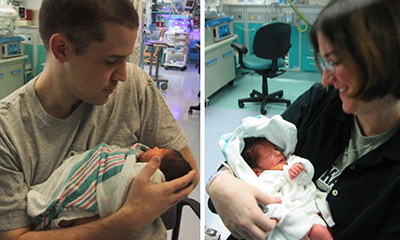Neonatologist Shares Successful Strategies for Improving Infant Health Outcomes
Babies born in the United States have a higher chance of death than babies born in more than 50 other countries in the world. Through national and local initiatives, infant mortality rates have dropped in recent years, and quality improvement efforts across the country are building on those successes to address this alarming statistic. To help accelerate improvements, NICHQ is committed to sharing innovative approaches from those working on the ground to improve outcomes.
The Children’s Hospital at Montefiore’s division of neonatology are pioneers in improvement, ranked by U.S. News for their excellent care and exceptional outcomes. Leading the charge on many of these improvements is Division of Neonatology Chief, Deborah Campbell, MD, FAAP.
“We take a holistic approach to perinatal health care in our hospital that reflects the goals of our state,” says Campbell. “We recognize that if you have healthier moms, you have healthier babies, and we’re trying to ensure the well-being of both by supporting approaches that foster family engagement and involvement.”
The NYSPQC is one of 48 state and multi-state networks participating on the Centers for Disease Control and Prevention-funded National Network of Perinatal Quality Collaboratives, an initiative working to improve health outcomes for moms and babies. As the national coordinating center, NICHQ enhances the coordination and communication of PQCs across the nation, advises state PQCs that are in early stages of developing their collaboratives, provides quality improvement technical assistance, and facilitates a Consultant’s Bureau of experts to support all PQC improvement efforts.
For the past decade, NICHQ and Montefiore have partnered on multiple initiatives focused on improving infant health outcomes, including a multi-year breastfeeding initiative and, more recently, the New York State Department of Health-led New York State Perinatal Quality Collaborative (NYSPQC), which seeks to improve maternal and infant health outcomes through evidence-based perinatal interventions. Over the course of this initiative, Montefiore has made significant improvements in maternal and infant care, including improving nutrition protocols for preterm infants; spreading safe sleep messages to reduce infant deaths; and testing strategies to lower rates of maternal hemorrhage, and related mortality and morbidity.
Below, Campbell shares successes and lessons-learned from these three critical efforts improving the health of mothers and babies.
Setting up a feeding protocol to optimize premature babies’ nutrition
Since preterm babies are often born with a low-birth weight and may have underdeveloped organs, they are at risk for infection, as well as growth and development disabilities, and can have difficulty feeding because they may be too small or sick to feed by bottle or breast. Optimizing nutrition for these babies can help them grow and result in life-changing and life-saving benefits.
Typically, premature babies are fed intravenously and then switched to tube feeding through the gastrointestinal track (known as enteral nutrition) when they are ready. One strategy that Campbell’s team tested to bring babies up to a healthy weight is early enteral nutrition, which starts feeding babies through the gastrointestinal tract sooner when compared to more traditional approaches.
“A standardized approach to early enteral nutrition has helped our babies get up to full nutrition faster and reduced the complications and risks associated with prolonged central venous catheter use,” says Campbell. “Since small babies frequently exhibit feeding intolerance, it’s best to have a protocol for how we introduce feedings and a plan to approach perceived feeding intolerance and determine when to interrupt feedings. Studies show that having clinicians agree on an approach to feeding helps babies more quickly reach full feedings [optimal nutrition for their weight], and we saw that during our improvement efforts. When we set up a standard feeding protocol, outcomes improved.”
According to Campbell, a successful feeding protocol should standardize timing (when to introduce enteral feedings and when to interrupt the feedings), quantity (how much you will feed the baby and how quickly you will advance the feeding), and nutrition (what you will feed the baby and how to fortify nutrition by adding the supplemental calories and protein preterm infants need).
Since breast milk translates to better outcomes for premature babies, Campbell’s team strove to increase breast milk provision whenever possible, either from tube feeding pumped breast milk until mothers can nurse, or from donor breast milk. As described in an article by Paula Meier, PhD, RN, “Breast pump-dependent mothers of preterm infants have specific, predictable barriers to the initiation and maintenance of lactation, which do not affect mothers of healthy term infants.” The use of donor milk serves as a bridge while mothers work too increase milk volume during the first critical weeks.
NICHQ’s Director of Applied Research and Evaluation Becky Russell, MSPH, Shares a Story About Dr. Campbell’s Care for Her Twin Sons When my sons were born 10 weeks early, Dr. Campbell cared for them for the six weeks they spent in the NICU. The care they received was undeniably the highest quality, but it was Dr. Campbell’s compassion and caring for us as parents, and recognition of our new family as a unit, that truly made the biggest impact on us. I will never forget her kind words after a difficult day, or the way she shared in our joy when a milestone was hit. Dr. Campbell continued to be a trusted source of information and guidance as we faced the new challenges that would come after we were out of the safe hospital environment. My sons are 14 years old now, and I still list Dr. Campbell as one of the most influential persons in their lives. 
|
Increasing safe sleep practices through compassionate conversations
Raising awareness about safe sleep practices, both in terms of where babies sleep and their sleep position, can help save the lives of thousands of babies who die in their sleep every year. Montefiore leveraged a multi-pronged approach to spreading safe sleep messages—training their providers on how to best mentor families on safe sleep recommendations, and partnering with prenatal sites and community-based organizations, so they could share a unified message. Follow-up surveys with families demonstrated the success of their efforts, with families expressing an increased understanding of safe sleep practices.
Changing behaviors requires more than sharing safe sleep guidelines though, Campbell explains; it requires conversations founded in compassion and understanding. This, she says, was the biggest lesson-learned from their work.
“We need to acknowledge that families are receiving competing messages from health care professionals after delivery,” says Campbell. “We’re talking to them about the importance of safe sleep position and location and, at the same time, we’re encouraging skin-to-skin contact and parent holding, which means baby is in the bed with mom who may fall asleep. It’s confusing for families.”
Acknowledging the potential for confusing health messages and the demands and exhaustion that come with recent delivery and caring for a newborn, and making room for conversations rather than lectures can help families understand how to put safe sleep recommendations into practice. Compassionate, open conversations also create a safe space for families to discuss their beliefs about parenting and infant sleep, and the barriers that may preclude them from following recommended guidelines. For example, families may not be comfortable sharing a cultural belief that differs from recommendations, and families who can’t afford a crib may be hesitant to make that known to a provider. Campbell advises taking time to talk with families about what they believe will keep their baby most safe. By meeting them where they are before describing best practices, health professionals can make sure families’ voices are heard, and their opinions respected.
“Parents want what is best for baby—whether they choose to bedshare or use a crib; they are doing it because it is what they think is best,” says Campbell. “That knowledge should frame our conversations, so families can speak openly and honestly, and we can then share information in a way that is more likely to be integrated in their beliefs and practices.”
Improving postpartum hemorrhage care
Most recently, Montefiore has engaged in the NYS Obstetric Hemorrhage Project—a joint effort of the NYSPQC, American College of Obstetricians and Gynecologists District II, Greater New York Hospital Association, Healthcare Association of New York State and NICHQ—testing a set of evidence-based strategies to improve postpartum hemorrhage care.
The hemorrhage initiative represents a purposeful shift towards a holistic approach to perinatal health care in the state, says Campbell. Trying to ensure the well-being and safety of mothers also improves outcomes for babies; the two are intertwined.
Learn about more strategies for improving postpartum hemorrhage care here.
While Campbell does not work directly with the obstetric team in the mother’s treatment, she’s witnessed their successes. Because of the initiative, Montefiore has worked to improve their obstetric hemorrhage protocol to more accurately measure, monitor, and report on blood loss. They’ve also standardized their massive transfusion protocol, so, if a hemorrhage occurs, the right people and resources are in place and activated quickly. Monthly simulations give everyone opportunities to practice, and life-saving care is becoming a reflex for all those involved.
What’s next?
While Montefiore’s successes are numerous, Campbell knows there is always room to improve. Along with continuing to drive improvements in perinatal care through the NYSPQC, Montefiore Medical Center’s Wakefield Campus has also recently joined the NICHQ-led National Action Partnership to Promote Safe Sleep (NAPPSS-IIN), funded by the Health Resources and Services Administration.
“We’re thrilled to continue our partnership with Montefiore and build on their work to improve safe sleep, support healthy breastfeeding and eliminate disparities associated with both,” says NICHQ Executive Project Director, Pat Heinrich, RN, MSN, CLE. “We’ll be working with the Montefiore’s Wakefield campus, which serves a diverse community at risk for high rates of sudden unexpected infant deaths. Together with 19 other hospital teams and prenatal partners, they’ll implement evidence-based strategies that support safe sleep and breastfeeding and develop a plan for sustaining the gains they make.”
Learn more about NAPPSS-IIN’s goals and progress in this recent article.
